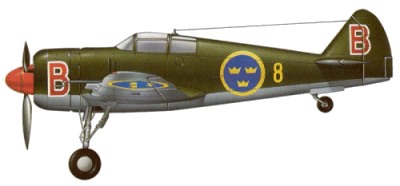
Entirely developed and
produced by the Swedish aeronautical industry, the J.22 fighter was the
result of an emergency program launched in order to overcome the
embargo placed on the export of aeronautical products by the United
States in October 1940. At the time, Sweden had ordered a total of 292
combat planes (consisting of fighters and fighter-bombers) from the
North American aeronautical industry. The fact that these were not
delivered literally caused a crisis in the country's air force (Svenska
Flygvapnet), which was urgently in need of reinforcements. Founded in
1926, the aircraft which it had in service were mainly British and
Italian in origin.

An emergency programme
was established to design and build a single-seat fighter relying upon
domestic industry and talent. The project (designation P.22) for the
J.22 was entrusted to a group of technicians led by Bo Lundberg and a
special centre, the FFVS (Flygförvaltningens Verkstad, or Aeronautical
Studies Workshop), was created to supervise and run the industrial
program. The production programme involved over 500 sub-contractors,
hardly any with experience of aircraft construction. Lundberg had as a
primary objective simplicity of manufacture and in this he succeeded.
Studies for the new aircraft began on 1 January 1941, and the first of
two J22 prototypes, built by Flygtekniska Försöksanstalten (FFA) near
Bromma, flew for the first time on 21 September 1942, from Bromma
airport, where the final assembly plant had been set up in a hanger.
Both prototypes crashed, one probably due to oxygen starvation of the
pilot, the other due to engine failure during landing.
The J.22 was a slender
single-seater monoplane, whose lines recalled those of the German
Focke-Wulf Fw 190, built following the simplest construction techniques
possible. In fact, its airframe was a mixture of wood and metal, while
the fuselage consisted of steel tubes covered in plywood. The forward
landing gear receded into the fuselage, and the tail wheel was also
retractable. It was powered by an SFA STWC3-G radial engine, which was
simply a 1,065 hp (794 kW) Pratt & Whitney SC3-G Twin Wasp produced on
license by the Swedish aeronautical industry.
The cycle of tests and
evaluations did not bring to light any serious faults, and the program
went ahead on the basis of an initial order for 60 production series
aircraft issued prior to the prototype's maiden flight. The first
production series aircraft was tested in September 1943, and the units
began to receive the new fighter in October. Deliveries went ahead
gradually and the J.22 could be considered fully operative in 1944. By
the end of the year, 75 had been built and they gradually replaced the
various Fiat CR.42s, Reggiane Re. 2000s, and Gloster Gladiators still
in service. In all, up till April 1946, 198 J.22s were completed in two
versions. These differed from each other solely in their armament. The
J.22A was provided with two 7.9 mm (0.31 in) and two 13.2 mm (0.52 in)
machine guns, while the J.22B had four 13.2 mm (0.52 in) weapons.
This fighter, which
remained in service until the 1950s, was used mainly by the units of
the Swedish air force based (F3 and F9 wings of the Swedish air arm),
based at Malmslätt and Gotenburg. In service, the J.22 proved to have a
good overall performance and, above all, to be extremely manoeuvrable.
Its only weak point was its lack of visibility while taxiing on the
ground. Experience gained in building the J.22 proved invaluable in
establishing Sweden's postwar aviation industry.
Specifications (FFVS
J.22B)
Type: Single
Seat Fighter
Design: FFVS
Design Team led by Bo Lundberg
Manufacturer:
Flygförvaltningens Verkstad (Aeronautical Studies Workshop) in
Stockholm
Powerplant: One
1,065 hp (794 kW) SFA STWC3-G 14-cylinder radial engine.
Performance:
Maximum speed 357 mph (575 km/h) at 11,485 ft (3500 m); service ceiling
30,510 ft (9300 m).
Range: 789 miles
(1270 km) on internal fuel.
Weight: Empty
equipped 4,453 lbs (2020 kg) with a maximum take-off weight of 6,250
lbs (2835 kg).
Dimensions: Span
32 ft 9 3/4 in (10.00 m); length 25 ft 7 in (7.80 m); height 8 ft 6 1/4
in (2.60 m); wing area 172.23 sq ft (16.00 sq m).
Armament:
(J.22A) Two 7.9 mm (0.31 in) machine guns and two 13.2 mm (0.52 in)
machine guns. (J.22B) Four 13.2 mm (0.52 in) machine guns.
Variants: J.22A,
J.22B (See Armament), S.22 (nine J.22A aircraft converted to
reconnaissance). In 1945 J.22A was redesignated J.22-1, J.22B into
J.22-2 and S.22 became S.22-3. In 1947 the nine S.22-3 aircraft were
converted back into fighters.
Avionics: None.
History: First
flight (prototype) 21 September 1942; first deliveries October 1943;
last delivery April 1946; retired from service 1952.
Operators:
Sweden (Flygvapnet). |
